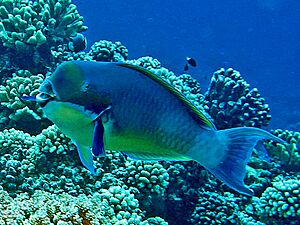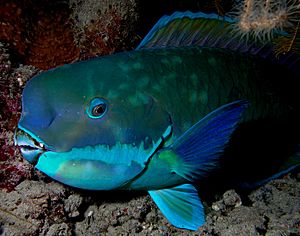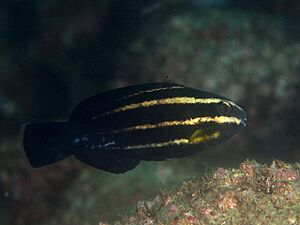Blunt-head parrotfish facts for kids
Quick facts for kids Blunt-head parrotfish |
|
|---|---|
 |
|
| Male Chlorurus microrhinos from French Polynesia | |
| Conservation status | |
| Scientific classification | |
| Synonyms | |
|
Callyodon microrhinus (Bleeker, 1854) |
The blunt-head parrotfish, also known as the steephead parrotfish, is a type of marine fish. Its scientific name is Chlorurus microrhinos. This fish belongs to the parrotfish family and lives in the Indo-Pacific region.
Contents
Where Do Blunt-Head Parrotfish Live?
These parrotfish are found in many places across the ocean. You can spot them in the eastern Indian Ocean and throughout the Pacific Ocean. Their home ranges from the Ryukyu and Ogasawara Islands to Indonesia. They also live near the Great Barrier Reef in Australia, Lord Howe Island, New Caledonia, and French Polynesia.
What is Their Habitat and How Do They Live?
Blunt-head parrotfish live in different underwater places. They can be found in calm lagoons, nearshore reefs, and even on the outer parts of ocean reefs. They usually live in waters between 2 and 50 meters deep.
What Do Blunt-Head Parrotfish Eat?
These fish are important for coral reefs. They often swim in groups, sometimes with about 40 fish. They search for food over lagoons and reefs that have lots of algae. They mainly eat algae and tiny bits they scrape off corals. This helps keep the reef clean and healthy.
How Big Do They Get and How Long Do They Live?
Blunt-head parrotfish grow quite fast. They can live for up to 15 years. Young parrotfish usually swim alone, but adults prefer to be in schools.
What Do Blunt-Head Parrotfish Look Like?
Chlorurus microrhinos can grow to be about 80 centimeters (about 31 inches) long. Most of these parrotfish are a greenish-blue color. They have a bright blue stripe behind their mouth and a wide blue patch on their head. Sometimes, a few fish might be a yellowish-tan color.
Special Features of Their Appearance
Their cheek has a wavy line, and the area below it is usually greenish-yellow. Older, larger fish tend to be dark greenish-brown. As they get even older, they might turn greenish-blue.
They have nine spines on their back fin and 10 soft rays. Their bottom fin has 3 spines and 9 soft rays. Young fish have a rounded tail, but large adult males have a tail shaped like a crescent moon. Adult blunt-head parrotfish have big, blue-green teeth plates that are easy to see. They might also have one or two pointed teeth on each side of their upper plate.
How Do They Change as They Grow?
Large male blunt-head parrotfish develop a big, noticeable forehead. This is why they are called "blunt-head" parrotfish! Young fish look different; they are black with some white stripes going across their body. The colors of these fish can also vary a bit depending on where they live, like in the Red Sea or the Pacific Ocean.
Who Discovered the Blunt-Head Parrotfish?
The blunt-head parrotfish was first officially described in 1854. A Dutch doctor and scientist named Pieter Bleeker gave it the scientific name Scarus microrhinos. He found the first one in Jakarta.




